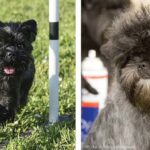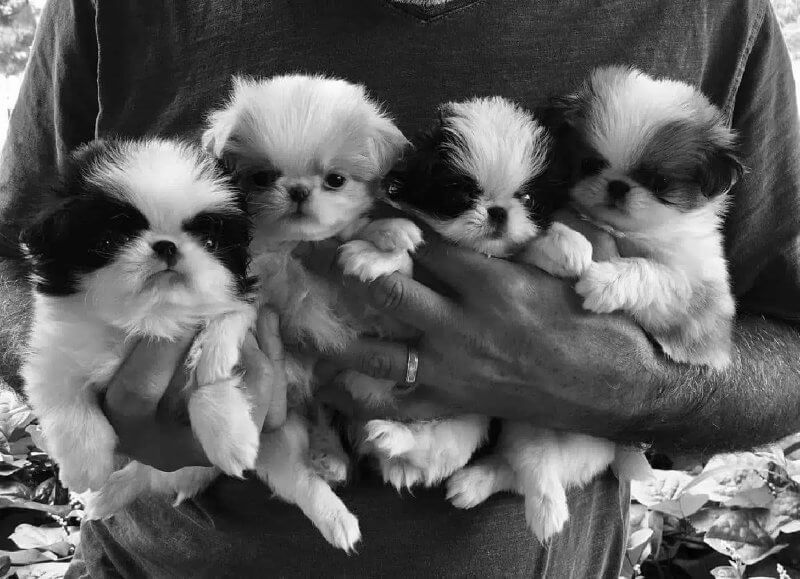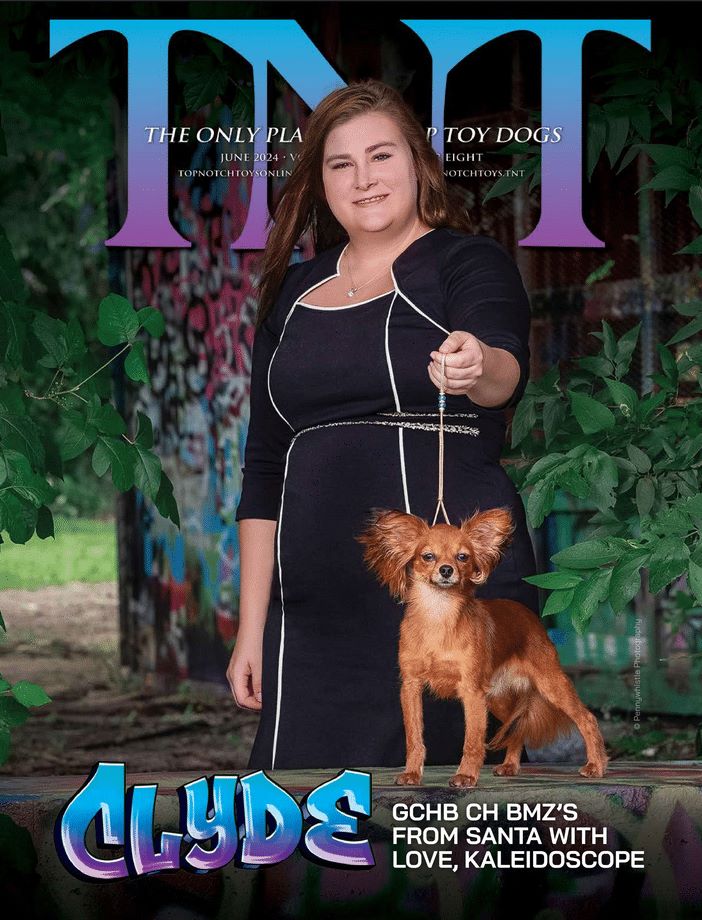Selecting a Japanese Chin Puppy | The first step to breeding and recognizing the desired quality of Chin is to be familiar with the breed standard. With the first two descriptive words being “A small” and the multiple references to fine boned it is clear the desired traits are with the smaller dog.
Our desired size in addition to the eight to 11 inches would be five to seven pounds as an adult, roughly translated that puts a seven pound adult at no more than two and a half pounds at 12 weeks. The 12 week size can be doubled with one additional pound for a fine boned dog and two to three pounds for a heavier boned puppy.
Well balanced is the key, check the size of the head to the circumference of the ribcage as they should be close to the same.
Many of times I have heard “This one had the biggest head.” That could be a statement of quality, if only it were on a small specimen. A 10+ pound Chin with a big head is nothing more than a big dog, there is no stylish, aristocratic movement or presence.
When looking at a Japanese Chin Puppy or adult standing or moving, there should be the appearance of a one piece dog that demonstrates the lively movement in a square package.
Next is the expression, the hallmark of the breed and those dark lustrous eyes that set the Chin apart from all others. Where the Pekingese standard calls for “massive” and “bold” features rather than “prettiness, daintiness or delicacy”, Chin are all about everything pretty, dainty and delicate.
No ropes, wrinkles or folds obscure the wide eyed open look of the Chin’s astonished oriental expression. The amount of cushion should be in proportion to the age and gender of the Chin, the Chin is a work in progress that will mature three years before full development. Too much too soon can be a fair indication of the old adage “early ripe… early rotten.” Nostrils should be open with clear air exchange, dog’s “mouth breathing” when temperatures are not high, could be a sign of concern.
In my opinion, any person qualified to evaluate a Chin should be able to easily check the bite without having to subject a Chin to the indignity of a oral exam, unless there is evidence of a wry mouth. The standard makes mention of their sensitivity, with eyes/nose/mouth area easily the size of a human thumb. No dog would like it and to a Chin it is just rude.
Alignment with a reverse scissors bite can be easily checked by touch and visual inspection, if you touch the tongue and the Chin can retract it, there is an acceptable bite.
So many times in the ring you will see a judge left to put up a lesser quality Chin after offending the better quality dog with an invasive oral exam.
There are many acceptable versions of facial markings with the symmetrical hourglass pattern being most desirable. Eyes should be large and dark, the lustrous or liquid eye gives the bright, inquisitive and intelligent expression the standard calls for. When the eyes are perfectly round and large, there will be a small amount of white showing in the inner corners, adding to the look of astonishment. The better heads will have the largest, wide-set eyes from the start to the finish of the maturing process with eyes being larger than the nose as gage to size and quality.
Round best describes the shape of the Chin’s eyes, top skull and forehead. There are no sharp edges on this soft oriental expression and, personally, I prefer the whiskers left to protect the eyes and add even more detail to
the face.
How the Chin stands on its front totally dictates the shape and movement of a puppy and how it keeps the desired shape. With the elbows tight to the chest, having a full rounded ribcage, the shoulder placement should allow for the high head carriage of this oriental aristocrat.
In my experience, the fine-boned Chin is a bladed bone leading to the lovely hare-shaped foot. If the bone is heavy and round, the toe is usually short. Moving straight, front and rear, the Chin with the most desirable rounded rib and hare shaped foot will stop at 11” and 1” for balance. Often times the inexperienced will fault this.
On the rear, angulation is the key, avoid the puppy that is straight in stifle even if it appears straighter in the hock. A Japanese Chin Puppy with angles will usually muscle and tighten up ending up with the sounder rear and more extension in movement. So many times the straight rears will appear to knuckle over and even cause the entire croup to be at a slant.
The crowning glory of the Chin’s outline is the tail. Flowing on the mature dog, it is a direct indicator of the Chin’s mood and outlook on the day.
I prefer a longer tailbone free of any kinks with good flexibility. The set is high off of the croup and with length to drop below the line of the spine and in a perfect world, on the judges side.
Sometimes standing around, the Chin will drop its tail (on lead) in boredom (shame on you for allowing your Chin to be bored!) but on the go it should be carried over the back on either side.
The texture of the Chin’s coat along with the pattern of longer and shorter hair is equally if not more important than the amount of coat.
Straight, single and silky with no undercoat you should be able to part the hair with two fingers to the skin. More profuse and standing out around the neck, shoulders and chest to form the mane or ruff with the longer coat in the rear making culottes or pants.
Chin do not have side skirts like a Shih Tzu and the amount and texture of their coat is part of the charm of this low upkeep companion dog.
With puppies and intact females, look for the desired pattern of coat and correct texture but only expect full coats on the adult males, primarily in the winter months.
This breed is no less ancient than the dogs of Malta and it is up to the integrity of the breeders to maintain this centuries old type. Many Chin of the 1800s would still be desirable to show and breed today. This is the heritage we must strive to honor.
Selecting a Japanese Chin Puppy









